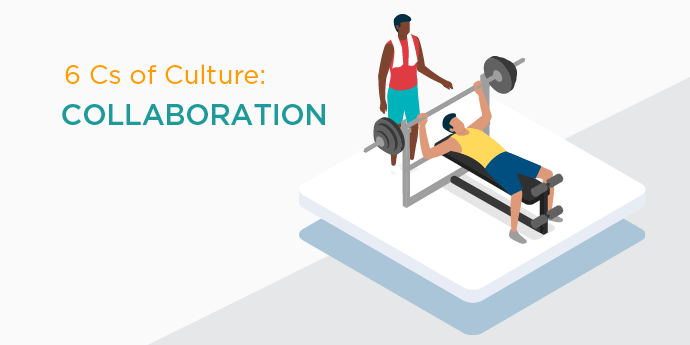
What makes an exceptional organizational culture?
As my colleague Sharon described last week, every environment will have a distinct feel and flavor, and there are a few consistent elements that are essential to creating an engaging, motivating workplace. We like to call those fundamentals the 6 Cs of Culture, which are highlighted in our Culture Fitness Toolkit.
They include:
- Communication
- Collaboration
- Care
- Connection
- Commendation
- Career
My colleagues and I are exploring each of the 6 Cs in our blog to offer one concept to spark a noticeable change to empower leaders to create healthy cultures. I’m focusing on Collaboration.
What Is the Impact of Collaboration?
Collaboration refers to the process and experience in which employees bring their distinct capabilities together and work collectively to produce higher-quality work overall. Using this definition, it’s important to reflect on the “distinct capabilities” that are brought together as part of teamwork. In addition to the many hard and soft skills that may come to mind, the differences also represent cognitive diversity, or variations in worldviews, beliefs and ways of thinking.
Cognitively diverse teams are shown to amplify performance. Deloitte reports that groups with disparate styles enhance innovation by about 20% and reduce risk by up to 30%. When organizations welcome different points of view and proactively promote collaboration, it can unleash untapped potential for both the business and its people.
Additionally, cooperation contributes to a greater sense of purpose, productivity and job satisfaction while reducing employee turnover. One Stanford study found that working in collaborative environments is 50% more effective than individual settings when it comes to intrinsic motivation, task completion and employee engagement. The benefits of having a synergetic culture are well-documented, making collaboration instrumental to a thriving workplace.
What Does a Culture of Teamwork Look Like?
When effective collaboration is an intrinsic part of a workplace environment, leaders and employees will consistently agree with the following statements:
#1 – Managers and leaders provide forums, such as town halls, chat channels, idea boxes and more, for staff to regularly share input, feedback and suggestions.
#2 – Employees know that their opinions count and are asked to share their subject matter expertise when challenges arise and solutions are needed.
#3 – Staff members participate in the process of setting goals and have an opportunity to weigh in on the priorities and projects that impact their roles.
#4 – The workforce uses instruments to identify and utilize the inherent gifts of all staff, including their cognitive makeup and work experience.
#5 – Personnel at all levels are appreciated for their contributions even when their ideas and opinions differ from those around them.
#6 – There are multiple tools and resources in place to promote collaboration in synchronous and asynchronous ways, including virtual whiteboards, project documents and trackers, messaging apps, calls and more.
#7 – Staff have received training and supporting materials to navigate disagreement and conflict management productively.
#8 – Team members are clear on who is accountable and responsible for all elements of the projects they are involved in and understand the expectations that are on themselves and others.
#9 – People managers are trained to lead effective meetings and empowered to support their staff when roadblocks arise.
#10 – Cognitive diversity is an integral part of the decision-making process with staff members routinely exploring other perspectives and engaging in diverse opinions.
What Is One Tip to Consider for this C of Culture?
From our work at Emergenetics, we know that Thinking and Behavioral preferences contribute to team dynamics. For example, some people may prefer to think independently before offering their thoughts in a brainstorm while others prefer to talk through what’s coming to mind, even if the concept isn’t fully formed. Other differences include individuals who generate their best ideas in a structured setting compared with those who find inspiration away from their workspace.
To accommodate the entire employee base, utilize the tips below to promote more effective coordination and cooperation:
- Send information ahead of time to staff to give space for those who prefer to be prepared and to ruminate on their thoughts
- Offer various settings for collaboration, whether that is a live or a virtual meeting to connect
- Clarify when options can still be considered by encouraging “thoughts in the night,” where ideas may be shared after the initial discussion
- Ask for the perspectives of all people to express value for everyone’s thoughts, especially for those who may prefer to keep the peace in conversation
- Grant room for respectful debate and questions so that ideas can be advocated and explained
- Promote company values and remind employees to honor them when collaborating
Emergenetics Associates – To supercharge teamwork, utilize our template for WEboarding (the Whole Emergenetics version of whiteboarding). The insights will empower you to help staff use cognitive diversity to make their collaborative conversations and ideations even more productive.
Applying intentional practices will support efficient cooperation in the workplace by inviting personnel to feel actively involved in advancing top priorities and moving the organization forward. As a result, the workforce will recognize the meaning of their work and the contributions of others.
To continue cultivating a culture of collaboration – or any of our other 6 Cs – we invite you to download our Culture Fitness Toolkit, which offers multiple ideas and resources to guide you on your way to a stronger workplace climate.
Download our toolkit today or fill out the form below to speak with one of our team members about how Emergenetics can advance collaboration in your company or school!
 Print This Post
Print This Post

